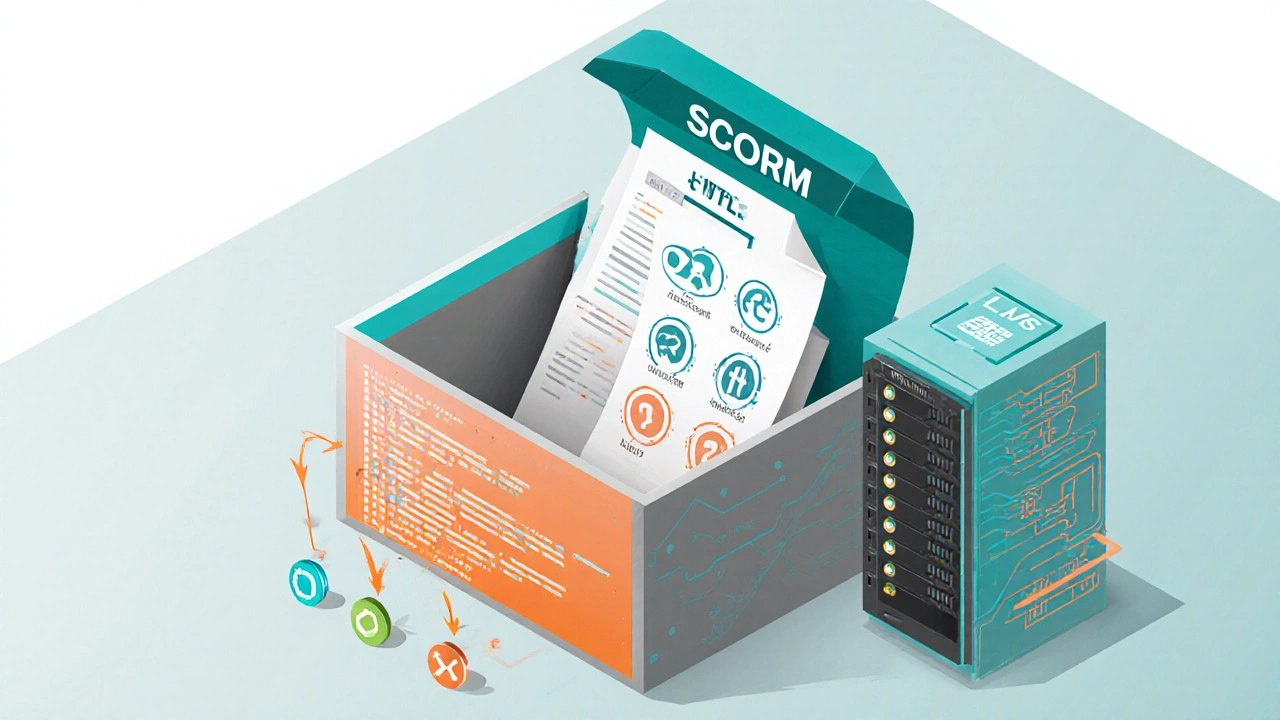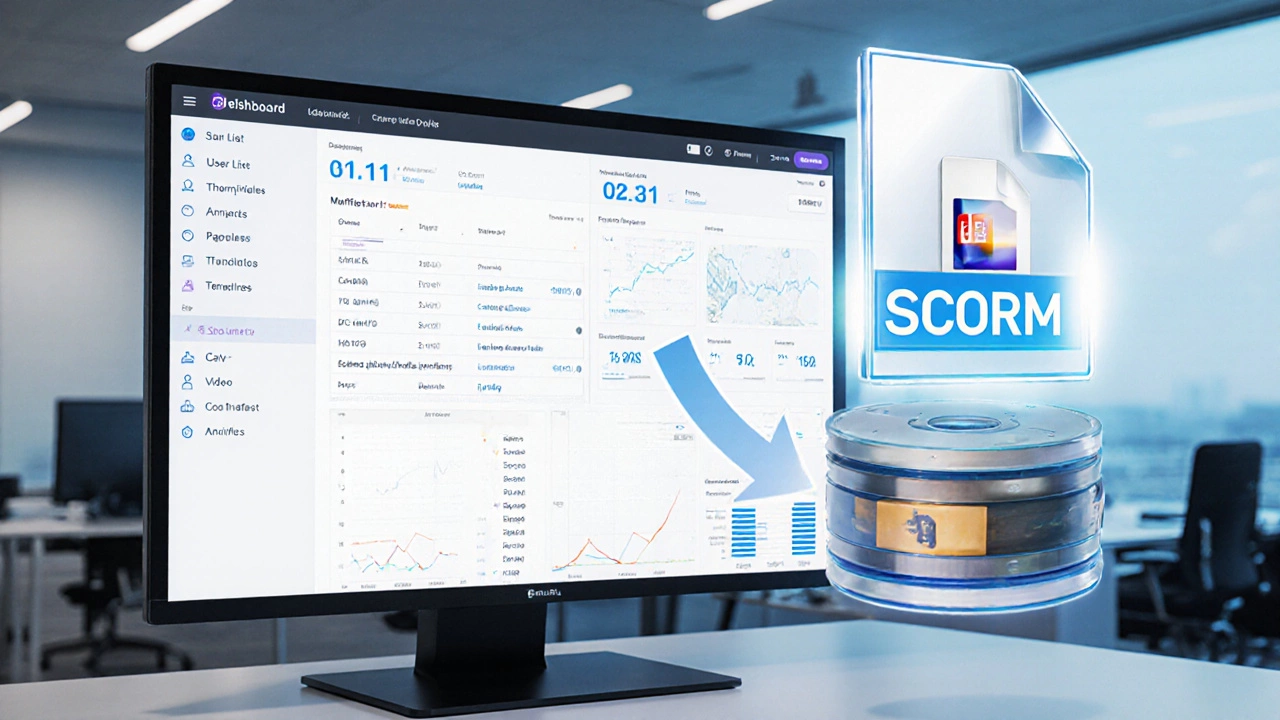When companies start building online training, the first question they hear is often: “What’s the difference between LMS and a learning management system that hosts, tracks, and delivers courses and SCORM a set of technical standards for packaging and communicating learning content?” Knowing the answer saves time, money, and headaches.
Quick Takeaways
- LMS is the platform you log into; SCORM is the format your course content follows.
- SCORM handles data exchange (scores, completion) between content and the LMS.
- Modern standards like xAPI extend what SCORM can do, especially for mobile and offline learning.
- Choosing the right combo depends on your reporting needs, technology stack, and budget.
Defining the Core Players
First, let’s pin down the two main entities.
Learning Management System (LMS) is a software application that stores, delivers, and tracks learning activities for users - think of it as the classroom you walk into online. It handles user accounts, enrollment, progress reports, and often integrates with HR or CRM tools.
SCORM stands for Sharable Content Object Reference Model, a set of specifications that define how learning content is packaged and how it talks to an LMS - picture it as the textbook format that guarantees any compatible LMS can read the material and record results.
Other related standards matter, too. xAPI (TinCanAPI) captures learning experiences beyond the browser, including mobile apps and simulations is the next‑generation cousin of SCORM. AICC is an older eLearning standard that relies on HTTP requests for communication still appears in legacy systems.
The IMS Global Learning Consortium the organization that maintains SCORM, xAPI, and other interoperability specifications oversees the evolution of these standards to keep the industry moving.
When content complies with SCORM, the LMS can launch the course, collect a score, mark it complete, and store that data in a Learning Record Store (LRS) a database that aggregates learning statements, especially those generated by xAPI.
How SCORM Works Inside an LMS
Think of a SCORM package as a zip file with three parts:
- A manifest (imsmanifest.xml) that tells the LMS what files exist and the navigation flow.
- The actual learning assets - HTML5, video, quizzes, etc.
- A JavaScript API wrapper that lets the content call LMS functions like
Initialize(),SetValue(), andTerminate().
When a learner clicks "Start" in the LMS, the platform extracts the manifest, builds the course structure, and launches the HTML5 pages in an iframe or new window. As the learner answers a quiz, the JavaScript calls SetValue('cmi.score.raw', 85), and the LMS stores that 85% score in its database.
If the LMS supports SCORM 2004, it can also track complex interactions such as sequencing rules - e.g., “only show Module3 after Module2 is completed with at least 80%.”
Key Differences at a Glance
| Aspect | LMS | SCORM |
|---|---|---|
| What it is | Software platform for delivery and tracking | Technical packaging and communication standard |
| Primary function | Manage users, enrollments, reports | Enable content to send scores, status, timestamps |
| Typical file type | Database entries, web UI | ZIP containing imsmanifest.xml + assets |
| Versioning | Updates via patches or SaaS releases | SCORM1.2, SCORM2004 (3rd/4th edition) |
| Compatibility goal | Host any compliant course | Ensure any SCORM‑compatible LMS can read the course |
| Reporting depth | Depends on LMS features (dashboards, analytics) | Limited to data points defined in the API (score, completion, time) | author
In short, the LMS is the host, while SCORM is the guest that knows how to talk to the host.

When to Use SCORM, When to Skip It
If your organization already has a robust LMS and you need to track simple quiz scores, SCORM 1.2 or 2004 works fine. It’s supported by most commercial platforms, including Moodle an open‑source LMS widely adopted by schools and businesses.
However, SCORM falls short when:
- You want offline learning - the standard assumes a continuous internet connection.
- You need granular activity tracking (e.g., how long a learner watched a video segment). xAPI fills that gap.
- Your content includes modern interactive formats like VR or mobile‑first simulations. SCORM’s JavaScript API can’t capture those events reliably.
In those cases, consider building a Content Package a collection of assets that follows xAPI statements for richer data capture and ensure your LMS or LRS can ingest them.
Practical Checklist for Choosing the Right Stack
- Identify reporting needs. Simple pass/fail? Then SCORM 1.2 may suffice. Complex competency maps? Look at xAPI.
- Check LMS compatibility. Does your LMS list SCORM 2004 as supported? Does it also accept xAPI statements?
- Assess content creation tools. Authoring tools like Articulate Storyline a popular eLearning authoring software that exports SCORM and xAPI packages can output both formats.
- Plan for future upgrades. Pick a platform that can evolve from SCORM to xAPI without rebuilding courses.
- Budget considerations. Open‑source LMSs (Moodle, Open edX) reduce licensing costs but may need technical staff for LRS integration.
Common Pitfalls and How to Avoid Them
Pitfall 1: Packing non‑HTML5 assets. SCORM 1.2 expects Flash or old technologies that most browsers block. Convert to HTML5 before export.
Pitfall 2: Ignoring version mismatches. Uploading a SCORM2004 package to an LMS that only supports SCORM1.2 will cause launch failures. Always verify the LMS’s supported version.
Pitfall 3: Over‑relying on default reporting. The LMS may only show “Completed” without score details unless the SCORM package explicitly sends them. Test the package in a sandbox before rollout.
Pitfall 4: Forgetting to configure the LMS for xAPI. Even if your authoring tool outputs xAPI, the LMS must have an LRS endpoint configured; otherwise data gets lost.

Future Trends: Beyond SCORM
The eLearning world is moving toward more flexible, data‑rich standards. While SCORM will remain in legacy environments for years, new projects are increasingly built on xAPI combined with Experience API another name for xAPI that emphasizes learning experiences across devices. This shift enables analytics that feed directly into performance dashboards and AI‑driven personalization.
At the same time, the rise of Learning Experience Platforms (LXPs) blurs the line between LMS and content delivery. LXPs often ingest SCORM, xAPI, and even video‑only content, presenting them in a consumer‑like interface. If you’re starting fresh, consider an LXP that can still host SCORM modules while you gradually adopt richer standards.
Bottom Line
Remember, LMS is the system you log into; SCORM is the format that lets that system understand your course and record results. Choose SCORM when you need reliable, widely‑supported packaging and simple tracking. Switch to xAPI or an LXP when you want deeper analytics, mobile‑first experiences, or offline capability. By matching the standard to your reporting goals and tech stack, you avoid costly re‑authoring down the line.
Frequently Asked Questions
Can an LMS run without SCORM packages?
Yes. An LMS can deliver native HTML courses, videos, PDFs, or even live webinars. SCORM is only needed when you want the LMS to automatically capture scores, completion status, and time‑spent data from packaged content.
Is SCORM still relevant in 2025?
Absolutely. Many corporate training programs still rely on SCORM because it’s universally supported. However, new projects often pair SCORM with xAPI or choose xAPI‑only for richer data capture.
What’s the difference between SCORM 1.2 and SCORM 2004?
SCORM1.2 provides basic launch and score tracking. SCORM2004 adds sequencing, navigation control, and better handling of interactions, making it suitable for more complex courses.
Do I need a separate LRS for xAPI?
Yes. xAPI statements are stored in a Learning Record Store. Some modern LMSs have built‑in LRS capabilities; otherwise you’ll need a standalone LRS to collect and query the data.
Can I convert an existing SCORM package to xAPI?
Conversion is possible but not automatic. You’ll need to re‑author or add an xAPI wrapper that captures the same interactions and sends them to an LRS.

